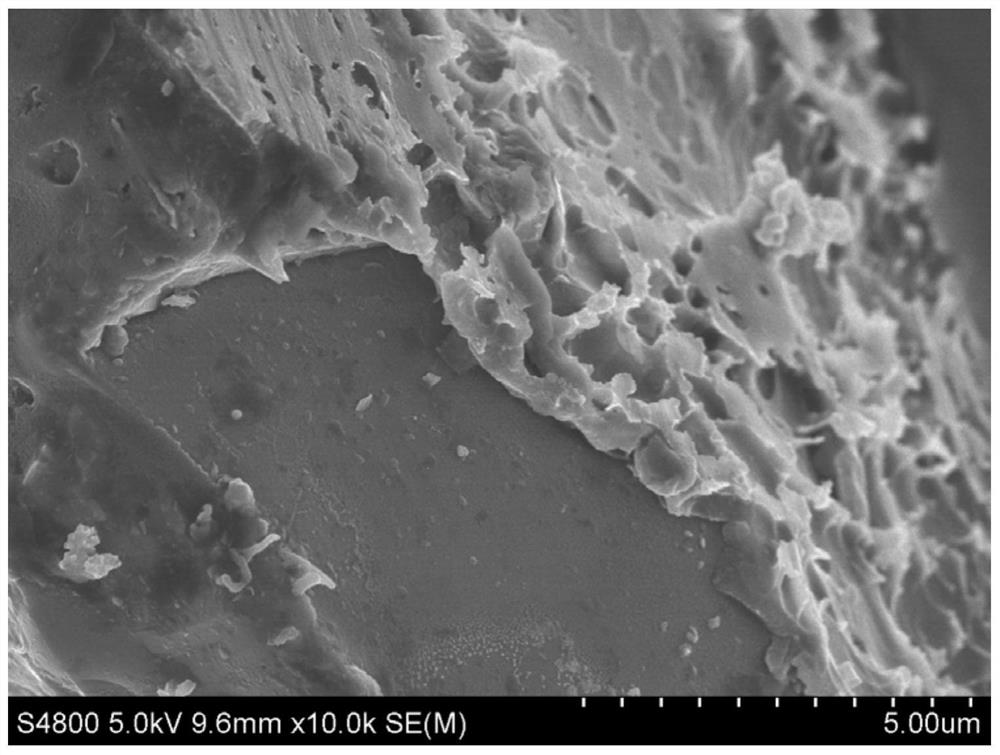A core-shell sic@c catalyst for microwave-assisted catalytic depolymerization of solid waste and its preparation method
A solid waste and microwave-assisted technology, applied in the field of catalytic conversion of waste resources, can solve the problems that the efficiency of microwave absorption and heat transfer is not as good as that of polar medium materials, and affect the catalytic conversion efficiency of catalysts, etc., and achieve efficient depolymerization of microwave absorption enhanced heat transfer and catalysis , promote high-efficiency and high-value utilization, and improve the effect of targeted regulation
- Summary
- Abstract
- Description
- Claims
- Application Information
AI Technical Summary
Problems solved by technology
Method used
Image
Examples
preparation example Construction
[0031] A method for preparing a core-shell SiC@C catalyst for microwave-assisted catalytic depolymerization of solid waste proposed by the present invention comprises the following steps:
[0032] (1) Put SiC in a reaction vessel, add 0.01 mol / L surfactant solution, and treat it at an ultrasonic frequency of 30-50 kHz for 20 min to form a suspension. The mass ratio of surfactant solution to SiC is (8~12):1. The surfactant is any one of sodium dodecylsulfate (SDS), sodium cetylsulfonate, sodium dodecylbenzenesulfonate and triethanolamine dodecylsulfate.
[0033] (2) Add resorcinol to the suspension in step (1), stir for 30-50 min to dissolve resorcinol completely, then add NaOH solution with a mass fraction of 10% and NaOH solution with a mass fraction of 37% formaldehyde solution, and then reacted with stirring at 25-30 °C for 6-8 h. The mass ratio of resorcinol to SiC is (0.2~3):1, the mass ratio of 10% NaOH solution to resorcinol is (1~3):1, and the mass ratio of formaldeh...
Embodiment 1
[0040] Put 1 g of SiC in the reaction vessel, add 8 g of sodium lauryl sulfate solution with a concentration of 0.01 mol / L, and treat it at an ultrasonic frequency of 30 kHz for 20 min to form a suspension. Then add 0.2 g of resorcinol to the suspension, stir for 30 min to completely dissolve the resorcinol, then add 0.2 g of NaOH solution with a mass fraction of 10%, and 0.1 g of a formaldehyde solution with a mass fraction of 37%, Then the reaction was stirred at 25 °C for 8 h. The obtained product was washed once with ethanol and once with deionized water, and then vacuum freeze-dried to obtain the SiC@RF catalyst carrier precursor. Take 1 g of the obtained SiC@RF catalyst support precursor, 2 In an atmosphere with a flow rate of 10 mL / min and a water vapor flow rate of 0.01 mL / min, the temperature was raised to 500 °C at a rate of 6 °C / min, and then kept for 6 h to obtain a SiC@C catalyst support. figure 1 Shown is the SEM image of the SiC@C catalyst carrier. It can be ...
Embodiment 2
[0042] Put 1 g of SiC in a reaction vessel, add 10 g of 0.01 mol / L sodium hexadecylsulfonate solution, and treat it at an ultrasonic frequency of 35 kHz for 20 min to form a suspension. Then add 1 g of resorcinol to the suspension, stir for 35 min to completely dissolve the resorcinol, then add 1.5 g of NaOH solution with a mass fraction of 10%, and 1 g of formaldehyde solution with a mass fraction of 37%. Then the reaction was stirred at 28 °C for 7.5 h. The obtained product was washed once with ethanol and twice with deionized water, and then spray-dried to obtain the SiC@RF catalyst carrier precursor. Take 1 g of the obtained SiC@RF catalyst support precursor, 2 In an atmosphere with a flow rate of 40 mL / min and a water vapor flow rate of 0.2 mL / min, the temperature was raised to 650 °C at a rate of 8 °C / min and kept for 5.5 h to obtain a SiC@C catalyst support. The SiC@C catalyst support was added to a concentration of 1 wt% CoCl 2 solution, stirred at room temperature ...
PUM
| Property | Measurement | Unit |
|---|---|---|
| particle diameter | aaaaa | aaaaa |
| specific surface area | aaaaa | aaaaa |
| wavelength | aaaaa | aaaaa |
Abstract
Description
Claims
Application Information
 Login to View More
Login to View More - R&D
- Intellectual Property
- Life Sciences
- Materials
- Tech Scout
- Unparalleled Data Quality
- Higher Quality Content
- 60% Fewer Hallucinations
Browse by: Latest US Patents, China's latest patents, Technical Efficacy Thesaurus, Application Domain, Technology Topic, Popular Technical Reports.
© 2025 PatSnap. All rights reserved.Legal|Privacy policy|Modern Slavery Act Transparency Statement|Sitemap|About US| Contact US: help@patsnap.com

